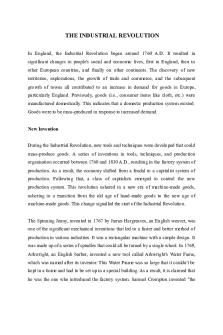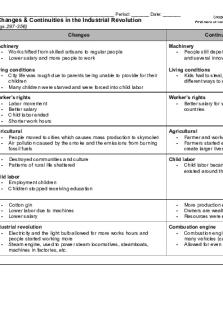Industrial Revolution in Canada PDF

| Title | Industrial Revolution in Canada |
|---|---|
| Author | Remo Garduce |
| Course | A Social History of Canada |
| Institution | Seneca College |
| Pages | 5 |
| File Size | 79.2 KB |
| File Type | |
| Total Downloads | 36 |
| Total Views | 141 |
Summary
Lecture by Timothy Bailey...
Description
Industrial Canada -Revolution first occurred in England late 18th century and early 19th century -For Canada, it began in 1850s and accelerated in 1870s and 1880s ->Before 1867, Canada was british north america, industrial revolution began before Canadian government began controlling things -More competition in England, so capital was moved to Canada for less competition ● What was Industrial Revolution -Technological advancement, new energy sources to automate production -Mobilization of capital for increase in investment -80% of worlds pop was engaged in farming prior to industrial revolution, the rest were crafts people to make tools and shoes, less than 1% engaged in agriculture today -Humanity used to rely on locally produced things, but industrial revolution stopped it and can be produced far away -Using machines and not hands, machines made tools and shoes, so goods are more available to people at lower cost -Subdivision of workers with less skills doing one job each deskilling, only press levers and turning wheels, only one task, before one person would have to make entire shoe ->Destroys labour, skills no longer needed, paid less -1780, shoemaker made 2 pairs of shoe a day, but a spindle jenny in 1792 and -1880, a person can make 300 pairs of shoes, increased production -Before, shoemaker or breadmaker could sell their skills, then machines came, and are now selling labour through wages -Changed the way to organize nature of work, different structure -It transformed socio-economic nature of society -Small scale rural and farming based society, independent commodity production, industrial revolution gave rise to urban society, cities developed around factories -People start migrating to country side to work, this demand constructed to buildings like shops and stores ● First Phase -1850, New energy source was steam power, powered trains to carry goods ->Clothing, furniture, boots, stoves -People used to work in homes, but factories would employ many people -The beginnings of the working class in Canada -Hamilton, Ontario, an old industrial town. In 1851, at beginning of first phase, only 25% of people worked in workshops of 10 or more people, more than 80% worked in workshops of 10 or more people 20 years later ->from market town to heavy industry
● Second Phase 1870s/80 to 1940 -New energy source was electricity -Steal, cars, paper, etc new industries mechanized -Urban centres expanded -Growth pulled people from rural areas -1891-1921, pop of Montreal and Toronto tripled -In 1921, half the population lived in cities ● Rise of Working Class -Pop of Canada in 1901 was 5.3 million, but pop was 7.2 million 10 years later -Labour force grew from 1.9 million in 1901, to 2.8 million in 1911 -Only 3.5 million people in Canada in 1867, ● Reorganization of Work -Rise of large corporations -Huge amount of resources needed to run -Pulling investments in machines and investing in labour to produce products -Industrial capitalism, investment in capital in machines and technology to increase production of marketable goods -Office Work is introduced, book keeping and accounting -Employers want more profit by cheepening labour, to produce as much goods for lowest cost, shift stress of working class ->Government slowly responds to new problem, so there’s lack of government understanding ->Very long hours, 12 hours average 6 days a week, worked to death and few pay ->Workers deskilled, employers don't needed skilled labourers, if they don't like them, they get fired, influenced poor position, massive surplus of labour and workers cant even complain -Rhythms of work, bad for working class ->Gruelling pace ->Arrive on time ->No compensations for injury -No laws for child labour ->Arent safe and worked for parents -Wages > Skills: industrial revolution -Work is somewhere away from home ● Employers wanting to maximize utility of machines -Taylorism, maximizing efficiency of factories at cheapest cost
-Peace work, paid by piece produced, if fastest worker can produce 100 and hour, then everybody has to, bad for health to do for long hours
-Rigid system of punishments for workers ● ->1889 Report of the Royal Commision on the relations of Labour and Capital -Originally in 1887 -Government investigating committee, examined effect of industrial revolution of working classes -Did interviews with workers and supervisors in Canadian cities, about 18,000 interviews -Workers needed courage to speak up, their jobs could be threatened ->14 year old in Montreal with arbitrary beatings, locked in windowless room at 7 hours at a time -Factories were dirty and dangerous, steam equipment could explode ->it was reported that workers lost fingers -Gasses could cause diseases ● The Family and Work -Most working class families were poor -Poverty was pronounced, families with husband not available were in precarious position -”Breadwinner ideal”, men are supposed to earn family wage and wives stay home and care for children, but this could not apply to working class, Toronto 1921, adult male blue collar factory worker paid only 2/3 of what is necessary to keep family above family line -It was necessary for women to be secondary wage earners, as was for children as well -Children can enter as young and 8 or 9 years old -1871, census reported that 25% of boys and 10% of girls over 10 years old had occupation outside of home -The things that made things convenient at home did not exist, like the laundry machine, “Blue Monday” laundry day with machines, took all day to do ● Children and Labour -Wives couldnt get out a make money, so children were sent for labour, cheap for the factories -Decisions influenced by the fact that boys earned more, so they kept girl at home for chores -Theophile, 1889 -14, worked at cigar factory for 3 years. $1 then $2 then $3 -Worked 10 hours a day
-Can be fined or blackholed if they were late or talked too much -Children were treated as adults, took away childhood, children often used cigars -James R Brown, inspector in Toronto factories ● Ontarios factories Act -Factory labour could not exceed 60 hours a week -Laws werent generally followed ● Women and Work -Women were always a part of it -53% of females participated in industrial work -majoirty of them were young and unmarried -Contributed almost all earning to family -”Breadwinner” -1889 reported that womens wages were ⅓ of what men were paid -1891-1911, women made ¼ of all workers -Employers noticed that demand for work was higher, so they could fire anyone and hire anyone ● Gender Division of Labour -”Breadwinner” legtimazed paying men more, and womens labour was actually ver necessary -Belief that women were incapable of heavy work, so they worked in dress making, food service ● Outcomes of exploitation -Rise of industrial unions -Protest movement ->Nine Hours Movement ->name came from goal: shorter working days to 9 hours ->from January to June in 1872 ->Began in Hamilton Ontario where they worked 12 hours a day, then spread to Toronto and montreal ->First time Canadian labour orgainzed into unified protest movement to improve working conditions of working class ->United union and non-union workers ->Montreal boasted 2000 members ->Organzied Toronto printer strike in streets attended by 10,000 workers in April 1872 ->1972, movement revberated throughout industrial Canada only to be quelled by recession in 1873 ->But it did produce solitary among workers which reemrged after recession
-In 1880s and 1890s, going on strike became established to attempt to win improvement for workers, knight of labour, group from 1869, concerned about worker control, encouraged workers to support each other ->To get employers to listen to them, improve working conditions -Thanks to these, workings hours reduced, higher pay and more benefits...
Similar Free PDFs

Industrial Revolution in Canada
- 5 Pages

Industrial Revolution
- 2 Pages

Industrial Revolution
- 19 Pages

THE Industrial Revolution
- 4 Pages

Industrial Revolution Essay
- 9 Pages

Industrial Revolution DBQ
- 8 Pages

Video-CC-Industrial Revolution
- 2 Pages

The third industrial revolution
- 2 Pages

Legal Frameworks in Canada
- 2 Pages
Popular Institutions
- Tinajero National High School - Annex
- Politeknik Caltex Riau
- Yokohama City University
- SGT University
- University of Al-Qadisiyah
- Divine Word College of Vigan
- Techniek College Rotterdam
- Universidade de Santiago
- Universiti Teknologi MARA Cawangan Johor Kampus Pasir Gudang
- Poltekkes Kemenkes Yogyakarta
- Baguio City National High School
- Colegio san marcos
- preparatoria uno
- Centro de Bachillerato Tecnológico Industrial y de Servicios No. 107
- Dalian Maritime University
- Quang Trung Secondary School
- Colegio Tecnológico en Informática
- Corporación Regional de Educación Superior
- Grupo CEDVA
- Dar Al Uloom University
- Centro de Estudios Preuniversitarios de la Universidad Nacional de Ingeniería
- 上智大学
- Aakash International School, Nuna Majara
- San Felipe Neri Catholic School
- Kang Chiao International School - New Taipei City
- Misamis Occidental National High School
- Institución Educativa Escuela Normal Juan Ladrilleros
- Kolehiyo ng Pantukan
- Batanes State College
- Instituto Continental
- Sekolah Menengah Kejuruan Kesehatan Kaltara (Tarakan)
- Colegio de La Inmaculada Concepcion - Cebu






